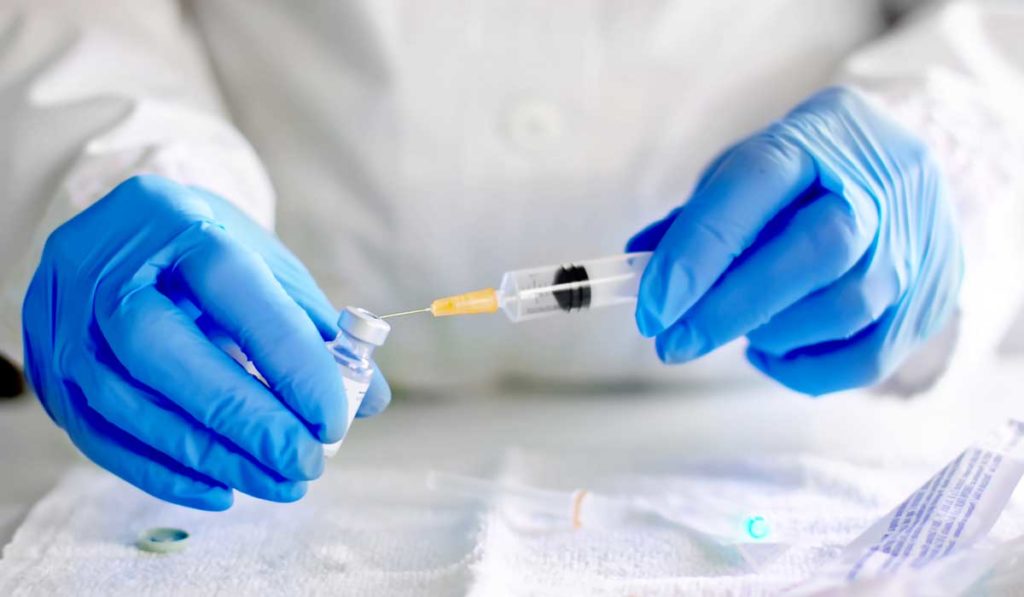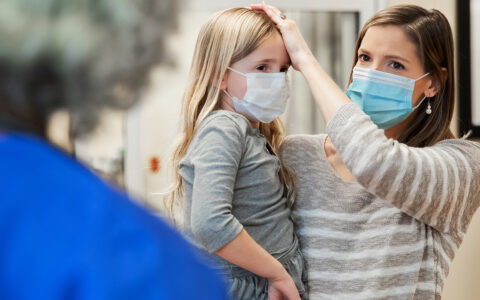On Tuesday, April 14, Vanderbilt University Medical Center hosted a virtual town hall to answer questions from community physicians and clinicians about patient care during the COVID-19 crisis. A panel of Vanderbilt experts discussed the current status of the pandemic in the Mid-South region, addressing current strategies for treatment, screening and new research into therapeutics.
Patty W. Wright, M.D., is associate director of the Division of Infectious Diseases at Vanderbilt. She provided an overview on treatment for COVID-19 infection based on clinical experience to date, plus the state of ongoing research efforts.
Population Trends
Discoveries: What does “flattening the curve” mean for our region? What have we accomplished to date?
Wright: Just like for other regions, flattening the curve means that while we are still having infections, the rate of spread is decreased so that at a given moment, fewer people are infected and needing hospital beds. By flattening the epidemic curve, we make sure that we have enough resources to care for everyone who gets infected. Based on modeling for our region, we will likely need to maintain social distancing measures through late May. If we relax too soon, we go straight back on the scary epidemic curve that leads us to a max with more patients than we have beds and staff to care for.
We’ve done a really good job keeping the infection rate down to a manageable level in Tennessee. We need to continue these social distancing efforts right now.
Discoveries: Health disparities are a rising concern with COVID-19. Is this an issue in our part of the country?
Wright: COVID-19 seems to disproportionately affect African Americans and Hispanics with higher mortality rates. There are a lot of factors that could relate to this, including access to health care and other comorbidities.
My understanding is that we’re seeing some of these trends in the Tennessee state data. Consuelo H. Wilkins, M.D., [vice president for health equity at Vanderbilt], has taken the lead in investigating this. She’s assembled an interdisciplinary team including André Churchwell, M.D., [chief diversity officer for Vanderbilt] and others to look at the data and find approaches to help minimize disparities in COVID-19 diagnosis and treatment.
Discoveries: What do we know about genetic factors that define the prognosis in patients affected by COVID-19?
Wright: Clearly there have been certain medical conditions that have been associated with COVID-19, and high morbidity and mortality in certain demographics like men and African Americans, but no one has yet found a particular gene that clearly defines risk of infection or prognosis.
Treatment Options
Discoveries: Why is it thought that chloroquine and hydroxychloroquine might be effective? What do you recommend at present on their use outside of a clinical trial setting?
Wright: These drugs have demonstrated in vitro activity against various viruses, but we haven’t seen as much activity in vivo. They have anti-inflammatory effects and clinical trials are underway.
At VUMC, if a patient doesn’t meet criteria for a clinical trial, then we’re using these medications for patients who are hospitalized and more likely to have a poor outcome — for example, a patient who is older or has multiple comorbidities. We’re not using chloroquine or hydroxychloroquine for outpatients. People with COVID-19 who are being managed as an outpatient are probably going to do just fine without these medications, and because of their side effects we’re not recommending them for more mild disease. Many people with COVID-19 get better so it is difficult to know which medications really have helped without clinical trials.
“Many people with COVID-19 get better so it is difficult to know which medications really have helped without clinical trials.”
Discoveries: What is current understanding of the role of hydroxychloroquine and Z-pak on management of outpatients with COVID-19?
Wright: The biggest issue with hydroxychloroquine is that it can cause QT prolongation and arrhythmias, particularly if a patient is on more than one medicine that causes these side effects. We’re not recommending hydroxychloroquine with azithromycin because the data are not convincing and the combination could cause arrhythmias.
Other contraindications for hydroxychloroquine include patients with seizure disorder on antiepileptics, long QT syndrome, sick sinus syndrome, and AV or bundle branch block.
Discoveries: With remdesivir and several antivirals now in clinical trials, should we be considering their use outside of a clinical trial setting (e.g., for compassionate use)? What is your current thinking on their ultimate benefit?
Wright: It’s now pretty difficult to get remdesivir outside of the current trial because of demand. As of last week, it was really only available for compassionate use in pregnant women and children who wouldn’t qualify for the trial.
Remdesivir looks great in vitro but is an intravenous medication and we need the trials to see when its use is most helpful. It may not be as helpful later in the course of the disease, for example, when patients go into acute respiratory distress syndrome. There was a small study released this week in the New England Journal of Medicine on compassionate use of remdesivir. It showed a 68 percent recovery rate for pretty sick patients. It’s not controlled, but it’s what we have so far, and those data looked good. I’m hopeful the trial will confirm it does have benefit.
Discoveries: What other promising treatments may be on the horizon?
Wright: IL-6 inhibitors have come forward as something that may be helpful, particularly for patients on the verge of having to go to the ICU because of a cytokine storm. A lot of places are now using those drugs off-label to inhibit the storm.
In our daily COVID-19 team meetings at Vanderbilt, we’ve talked about using tocilizumab. It is something that we’re considering. Again, it seems like it helps, but without a clinical trial it’s hard to know.
Immunologic Insights
Discoveries: What is our current experience with use of monoclonal antibodies?
Wright: We do have researchers looking into developing those, but they’ve not yet made it into clinical testing at Vanderbilt. James Crowe, M.D., [director of the Vanderbilt Vaccine Center] and his team are working on this because of their successes with other types of infections. For respiratory syncytial virus (RSV), for example, there are monoclonal antibodies available that can help some patients. But these kinds of therapies take a long time to develop. Monoclonal antibodies are harder to manufacture than other medications. That limits their utility – they’re really hard to scale up.
Discoveries: What is the current standing of treatment using convalescent serum?
Wright: Because we have access to other trials at Vanderbilt, convalescent serum isn’t something that’s risen to the top as something that we’re studying right now. I know some of my colleagues at smaller hospitals where they’re not doing clinical trials have set up programs to administer convalescent serum. It’s a therapy that might help, but we won’t know for sure without a clinical trial.
Discoveries: What is the role for serology testing?
Wright: Serology is really just getting up and going. One of the worries we’ve had is that for a lot of infections, IgM – the first antibody your body produces in response to an infection – often gives false positives. The IgG produced later on tends to be more specific to a particular infection. Serology tests that I’m seeing right now can have a false positive rate with IgM of about 10 percent. Our worry is we don’t want people to get a serology test, have it interpreted wrong, and think they’re immune. Serology will probably be most helpful for people who we can trace back to having had illness and 14 days later their IgG is positive. That will be the true positive.
Long-term Outlook
Discoveries: What are ways that we can accelerate the resolution of the crisis?
Wright: I honestly think it’s not about accelerating resolution, it’s really about slowing down the rate of infection. We’re not going to resolve this until we have an effective vaccine. We need to focus on keeping our peak flat so that we can handle the number of patients in the ICU and those needing hospital beds. We need to continue what we’re doing with social distancing and keeping the rate of infection low.
This is just an example of why we should keep doing the basics in medicine. Good hand hygiene, foundational things — to not take those for granted.
Discoveries: What are the chances of another severe viral pandemic in the next 5 years?
Wright: Being an infectious diseases doctor, we’re always looking for new or reemerging infections that come to the surface. Most of the time they burn themselves out. We saw the first SARS, then MERS, and of course Ebola pops up periodically. We always worry about the next new strain of influenza or other respiratory viruses. The next bad flu is only a matter of time. The novel coronaviruses have been a concern because they can have a really high death rate. Everyone is afraid of hemorrhagic viruses like Ebola, but in reality transmission is more difficult with Ebola versus these coronaviruses that are transmitted when we cough or breathe on each other. That’s a harder thing to control.
There’s always a potential that the next pathogen will take off. But to have it on the level we have it now, fortunately, is not something we see very often. This is why we have to keep funding public health and the CDC. There is always a new pathogen right around the corner.
“To have it on the level we have it now, fortunately, is not something we see very often. This is why we have to keep funding public health and the CDC. There is always a new pathogen right around the corner.”





